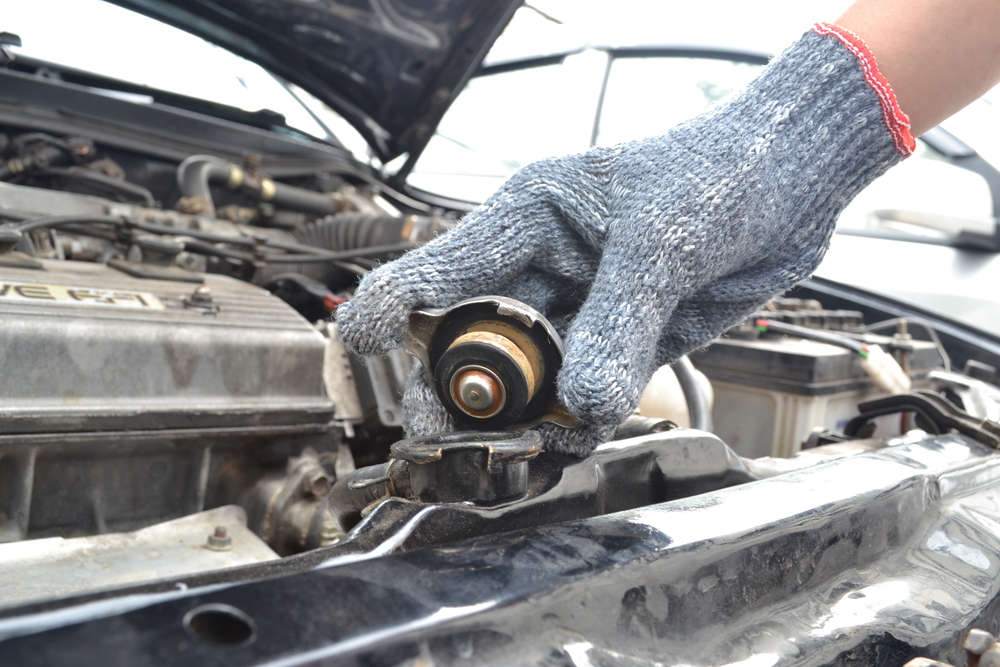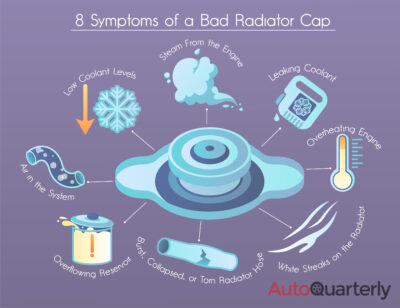Your cooling system, which includes your radiator and its hoses, is a component that often runs into problems. When you notice that your car is no longer regulating its temperature, chances are you have a radiator problem.
The bad news is your radiator could run into numerous issues. The good news is that a bad radiator cap is one of the most common issues you find, and it’s straightforward and cheap to diagnose and replace.
Here’s a look at some symptoms of a bad radiator cap, along with what you can do to alleviate the problem.
What Is a Radiator Cap?
When you open your vehicle’s hood, your radiator cap is one of the first things you’ll see. Your radiator is right at the front of the car, and the cap rests at the top of it. It’s a metal object and is immediately visible.
However, there’s more to this component than meets the eye. Under the metal cover are two valves responsible for maintaining the pressure inside your cooling system. There’s also a spring, gasket, and seal, all of which come together to help this device regulate your radiator’s pressure.
Once your radiator cap starts breaking down, it’s unable to keep the whole radiator at its ideal pressure, causing further problems for the vehicle’s temperature and leading to leaks and breaks in other cooling system components.
How Does a Radiator Cap Work?
A radiator cap’s main job is to keep a vehicle’s cooling system pressurized at optimal levels. Generally, a cooling system will require a PSI of between 13 and 16 pounds to prevent the coolant from boiling. This pressure increases the coolant’s boiling point, allowing this liquid to do a better job of cooling the engine.
It’s important to note that most vehicle engines operate at right around the boiling point of water. When the radiator isn’t adequately pressurized, the near-boiling liquid can escape as a gas. Also, gas isn’t as efficient at regulating temperatures as water, so even if the gas doesn’t escape, it will struggle to cool the engine.
The radiator cap’s valves work by regulating the radiator’s internal pressure and preventing coolant from running from the radiator. The result is an engine that stays within its ideal temperature range.
A bad radiator cap might also cause too much pressure throughout the cooling system, blowing hoses and causing a complete cooling system failure. As this pressure builds up, it has nowhere to go and will eventually find the system’s weakest point to release itself. Cooling system repairs can be costly, so replacing the radiator cap before this occurs saves cash.
You should be aware of early warning signs of a bad radiator cap so you can address this issue before it has the chance to do severe damage to your car.
8 Symptoms of a Bad Radiator Cap
The good news is that you don’t have to be a car expert to identify and replace a bad radiator cap. All you have to do is keep an eye on your car and look for a few simple warning signs.
Many of these signals are easily visible outside the car, while others will require some basic vehicle know-how. However, most car owners have the ability to check their cooling systems periodically.
1. Leaking Coolant
One of the most obvious signs that you have an issue with your cooling system is when you notice coolant all over your driveway. These leaks can occur when the vehicle is sitting overnight or right after returning home from a drive.
However, many different problems can lead to a puddle of coolant in your driveway, so you’ll want to troubleshoot before coming up with a fix.
Start by checking your radiator cap to see if it’s stuck. When the cap gets jammed, its valves might not work correctly. The result is a pressure build-up that can damage your cooling system’s hoses and cause leaks.
You should also see if the coolant is leaking from the top of the radiator where the cap goes. This leak could mean that the seal is gone, and a replacement is necessary.
If you find yourself in either of these scenarios, the radiator cap is likely the culprit. Remember that you’ll have to replace the leaking hose to return your cooling system to working order.
While waiting to replace your cap, you can use a radiator stop leak product to mitigate the leak for a short while.
2. Overheating Engine
Another obvious sign that something is wrong with your radiator is an overheating engine. When this happens, your car’s temperature gauge could reach critical levels, and the motor could shut down.
Once again, you’ll encounter a few different underlying causes of an overheating engine. However, they usually involve not having enough coolant to regulate the car’s temperature.
Wait for the engine to cool before popping your hood. From there, you can have a look at your radiator cap and all of the hoses. Check your fluid levels, too.
If you notice fluid near the radiator cap while doing your inspection, that’s probably where the coolant is escaping, and, luckily, replacing the cap only takes a few minutes.
3. White Streaks on the Radiator
A more subtle sign that something is wrong with your cap is when you notice white streaks on your radiator.
As coolant leaks from the top of your radiator, it dries and leaves these white strips behind. The good news is that as long as you haven’t noticed pools of coolant under your vehicle, the problem is relatively minor as long as you address it right away.
The gist is that these streaks mean your radiator is leaking from the top intermittently or when it’s under pressure as your car runs. Replacing the cap should fix the problem.
4. Overflowing Reservoir
As coolant heats, it expands. One of the radiator cap’s jobs is to release this extra pressure by sending some of this coolant to an overflow tank.
However, a faulty radiator cap could cause the coolant to release too quickly, leading to an overflowing reservoir. The overflow tank can also overflow in this scenario, leading to a pool of coolant under your vehicle.
5. Steam From the Engine
The most dramatic sign that you have a bad radiator cap is steam coming from under your hood. You’ve probably seen an overheating, steaming vehicle sitting on the side of the road at some point, as this often occurs when boiling coolant escapes from the radiator.
If it looks as though the steam is coming from the area around the cap, it probably means that you don’t have a reliable seal there. You’ll need to replace the radiator cap to repair the seal and get the car operational again.
6. Some Air in the System
A radiator cap that doesn’t provide an adequate seal could let air into the cooling system. The result is air pockets inside of the hoses and thermostat, making it more difficult for your radiator to regulate the vehicle’s temperature.
The reason is that it’s more challenging to regulate the temperature of air than liquid. Therefore, when air gets into the system, it heats up and causes the car’s internal components to do the same.
There’s no easy way to tell if you have air in your cooling system, but it could cause your car to overheat.
Fortunately, a new radiator cap can repair the seal, ensuring the cooling system can maintain ideal temperatures.
7. Low Coolant Levels
Check your coolant levels frequently to identify a problem pre-emptively. While coolant will slowly evaporate over time, quickly losing this fluid is a sign of an issue in your cooling system.
Never run your engine when the coolant is below a recommended level, and check your radiator cap for problems if you find that you’re continually having to fill it.
Coolant can escape from the cap if the seal is gone, causing a fluid shortage in your radiator. By checking your coolant levels, you can identify cooling system problems early in the process and prevent more serious damage.
8. Burst, Collapsed, or Torn Radiator Hose
Hoses are responsible for carrying the coolant from the radiator to the engine to regulate the vehicle’s temperature. When you run into a problem with these hoses, the car can quickly overheat.
In situations where the radiator cap isn’t efficiently regulating the cooling system’s pressure, the hoses can experience problems.
A burst or torn hose, for example, can occur when the cooling system is under too much pressure. The result is coolant spraying all over the car’s engine bay.
Often, a burst or torn hose starts as a minor leak. These pinhole leaks might only allow a small amount of fluid to escape, so you won’t notice the issue immediately. Eventually, the radiator’s pressure can cause the hose to burst, at which point the car becomes undrivable until you complete the repair.
You can identify potential hose problems by frequently checking your overflow reservoir and ensuring that it isn’t too full.
A collapsed hose is slightly different because it’s caused by a vacuum-like effect when your radiator cap isn’t releasing pressure when you turn off the vehicle. The hose can collapse on itself, and if you don’t address the issue, it could end up breaking.
If you find yourself in any of these situations, check your radiator cap for damage and replace it if necessary.
How to Check a Radiator Cap

In circumstances where you believe something is wrong with your cooling system, checking the radiator cap should be your first step because it’s the most straightforward aspect to repair.
Remember, the cap and radiator are extremely hot, so wait for the car to cool before starting any inspection.
Visual Inspection
The first thing you’ll want to do is complete a visual inspection of your radiator cap. This process involves removing the cap and having a look at its seals. There could be debris built-up on the gaskets, which you can clean with water and a toothpick.
You should also test the spring to ensure that it moves freely and check for corrosion on the inside of the cap.
It’s also a good idea to double-check the PSI rating on the cap to ensure it meets your car’s requirements. If this isn’t the original radiator cap, and the vehicle owner chose one with the wrong PSI rating, you could experience problems.
Pressure Testing
You might also try pressure testing your radiator to quickly determine if the cap is an issue or if something else is going on. This process requires a specialized tool called a radiator pressure tester.
To complete the test, you’ll need to pop your hood and locate the radiator. You’ll then remove the cap and screw the testing device onto the radiator in its place.
If you’ve been experiencing radiator pressure problems, but the tester says that the radiator is OK, the cap is probably the issue.
Likewise, if the tester shows that the radiator isn’t holding its pressure, there’s probably another problem somewhere in the cooling system. Since this tester pressurizes the cooling system, it gives you the chance to look for leaks without running the vehicle.
These testing systems are a quick and easy way to identify radiator problems without going to a mechanic.
Replacing a Radiator Cap
Consider yourself lucky if you determine that your radiator cap is the root of your cooling system problems. That’s because these devices generally cost less than $15, with some running you less than $10.
To replace the radiator cap, all you need to do is unscrew the old one in a counter-clockwise direction and put the new one on in its place.
However, you must select a cap with the right PSI rating to meet your vehicle needs. Choosing a cap that creates too little or too much pressure is a surefire way to develop even more cooling system problems in the future. Refer to your car’s manual to figure out which one is right for you.
Wrapping Up
Knowing when it’s time to replace your radiator cap can eliminate future cooling system difficulties and provides an easy fix when your engine is overheating, or coolant is leaking all over your driveway. If you notice any of these problems, check the radiator cap for visible damage or proactively replace it to see if it fixes the issue. A new radiator cap will only cost you a few dollars but can save you hundreds of dollars in repairs if you address it early enough.



